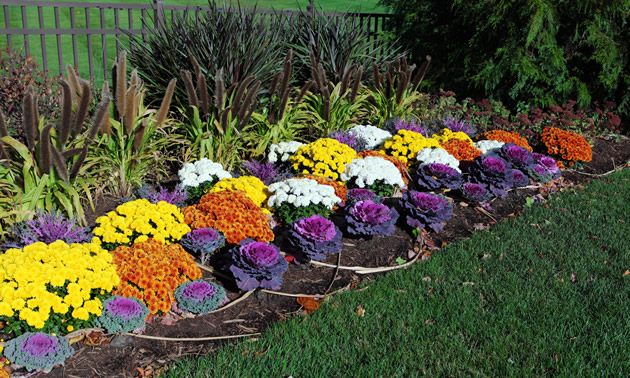Edimentals: edible, ornamental plants
Try a new approach to landscaping your yard by adding edimentals

Ornamental kale in the foreground is edible and adds to the beauty of a traditional flower garden. — CanStock photo/Dole
Imagine a patio edged with trellises covered in pole beans, cucumbers or grapes. Or picture a row of pretty purple cabbage interspersed with ivory white heads of cauliflower in front of your foundation shrubs. No longer do edible plants have to be relegated to the garden patch. They can be interspersed with ornamental plants throughout your yard.
Stephen Barstow of Norway coined the word edimentals for plants that serve double-duty as being both ornamental and edible. He authored the book Around the World in 80 Plants: An Edible Perennial Vegetable Adventure for Temperate Climates.
Edimentals might require a shift in thinking. Cultivated lawns and ornamentals often occupy good land that could be used more productively to grow food. The benefits are numerous: saving money on your grocery bills; eating fresher, more nutritional foods; and having a smaller ecological footprint.
How do you start your edible landscape? You could replace a few shrubs with easily grown culinary plants. Next you could take out a few hundred square feet of lawn to create a decorative edible border. It doesn’t have to be done all at once; you can add edimentals patch-by-patch or row-by-row.
Try these edimentals
Perennial herbs are attractive and easy to grow, and the flowers would provide great forage for native pollinators. Neat rows of chives are attractive, and thyme can be used as a ground cover where mowing a lawn may be challenging. But beware where you plant some herbs such as many mints as they can be invasive.
All the greens such as lettuces, spinaches and kales deserve to be planted in blocks or clusters. Many familiar ornamental flowers are also edible and can add a splash of colour to your salads, so plant nasturtiums and violets close to the kitchen door.
A bolder look can be achieved with robust rhubarb or Swiss chard, which comes in a rainbow of vibrant colours. After you’re done picking asparagus shoots, the tall feathery leaves would make an attractive backdrop for other decorative plants.
Edible plants include shrubs and trees along with herbaceous plants. A group planting of blueberries, Saskatoons or elderberries would be attractive to the eye and palate.
You could also plant edibles to share with our feathered friends. Many birds eat rosehips and sunflower seeds. If you don’t want to share with our urban deer, you may have to fence in all or part of your yard.






Comments